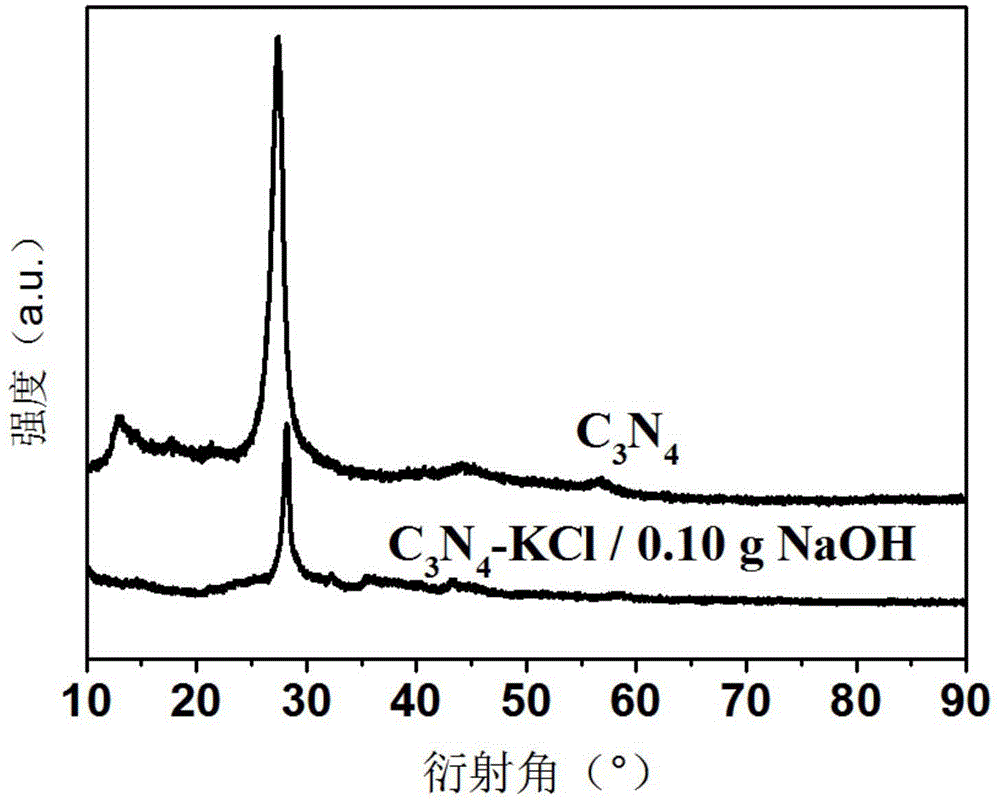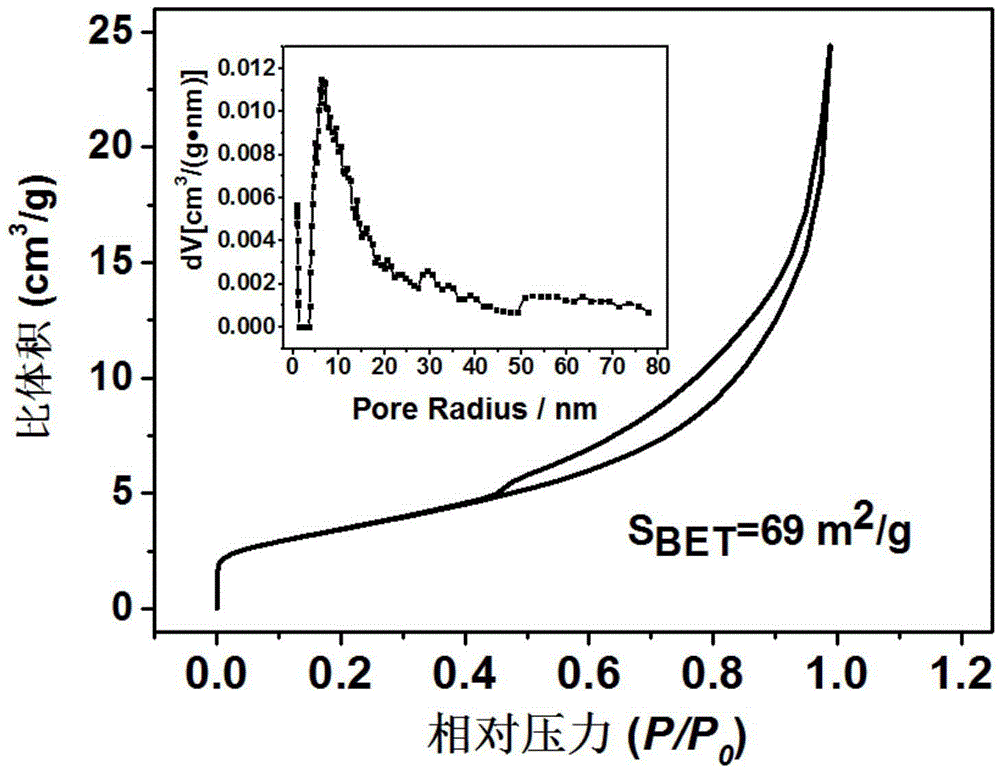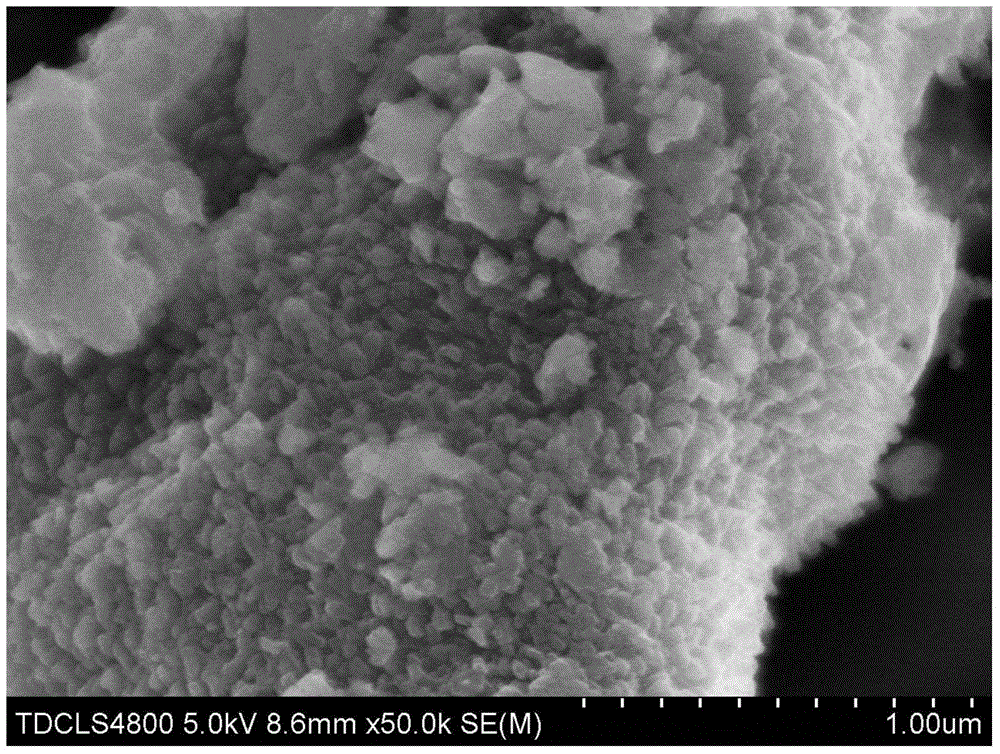Surface-hydroxylated nano-pore carbon nitride photocatalytic material as well as preparation method and application thereof
A technology for hydroxylation of nanoporous carbon nitride photocatalytic materials, applied in chemical instruments and methods, separation methods, dispersed particle separation, etc., to achieve the effects of facilitating photodegradation, increasing crystallinity, and increasing specific surface area
- Summary
- Abstract
- Description
- Claims
- Application Information
AI Technical Summary
Problems solved by technology
Method used
Image
Examples
Embodiment 1
[0031] Preparation of surface hydroxylated nanoporous carbon nitride: Weigh 1.5g of melamine, 7.5g of potassium chloride, and 0.1g of sodium hydroxide, grind the mixed powder in a mortar for 10-30min, mix well, and place in a crucible. Seal the mouth of the crucible with aluminum foil, place it in a muffle furnace and heat it up to 550°C and keep it warm for 4 hours. The sintered powder is ground with a mortar, separated by suction filtration with deionized water, and dried at 80°C for 4 hours to obtain Yellow nanoporous carbon nitride.
[0032] Some structural studies were performed on the nanoporous carbon nitride product (labeled C3N4-KCl / 0.1 g NaOH) prepared by the above method. figure 1 Be the XRD figure of nanoporous carbon nitride material, the product that illustrates preparation is carbon nitride; BET analysis ( figure 2 ) shows that carbon nitride has about 69m 2 / g specific surface area, the nanopore size is mainly distributed around 7nm; scanning electron micros...
Embodiment 2
[0034] The influence of sintering temperature and holding time on the product: weigh twelve parts of 1.5g of melamine, 7.5g of potassium chloride and 0.1g of sodium hydroxide, and grind the mixed powder in a mortar for 10 to 30 minutes. In the crucible, seal the mouth of the crucible with aluminum foil, place it in a muffle furnace and raise the temperature to 400°C, 500°C, 550°C, and 600°C respectively, and keep warm at each temperature for 2h, 3h, and 4h respectively. After sintering The powder was ground with a mortar, washed with deionized water and separated by suction filtration. The separated sample was dried at 80°C for 4 hours to obtain a yellow nanoporous carbon nitride. Through the comparison and analysis of the test results of the products in this case, it can be seen that with the increase of the holding temperature and holding time, the yield is getting lower and lower. Merit.
Embodiment 3
[0036]The impact of the amount of alkali metal chloride on the product: Weigh four parts of 1.5g of melamine and 0.1g of sodium hydroxide, then add 0.15g, 1.5g, 7.5g, and 30g of potassium chloride to the four samples, and mix the raw materials Grind in a mortar for 10 to 30 minutes, mix well, place in a crucible, seal the mouth of the crucible with aluminum foil, put it in a muffle furnace to raise the temperature to 550°C and keep it warm for 4 hours, and use a mortar to sinter the powder Grind, wash with deionized water, and separate by suction filtration. The separated sample is dried at 80° C. for 4 hours to obtain yellow nanoporous carbon nitride. Through the analysis of the test results of the product of this case, it can be known that the crystallinity and specific surface area of the product show a trend of rising first and then decreasing with the increase of the amount of alkali metal chloride. When the consumption of potassium chloride was 7.5g, the specific surfac...
PUM
| Property | Measurement | Unit |
|---|---|---|
| Aperture | aaaaa | aaaaa |
| Aperture | aaaaa | aaaaa |
| Specific surface area | aaaaa | aaaaa |
Abstract
Description
Claims
Application Information
 Login to View More
Login to View More - R&D
- Intellectual Property
- Life Sciences
- Materials
- Tech Scout
- Unparalleled Data Quality
- Higher Quality Content
- 60% Fewer Hallucinations
Browse by: Latest US Patents, China's latest patents, Technical Efficacy Thesaurus, Application Domain, Technology Topic, Popular Technical Reports.
© 2025 PatSnap. All rights reserved.Legal|Privacy policy|Modern Slavery Act Transparency Statement|Sitemap|About US| Contact US: help@patsnap.com



